Food Safety Management Report: Strategies for New Restaurant Launch
VerifiedAdded on 2020/11/23
|14
|3984
|378
Report
AI Summary
This report, focused on Clos Maggiore restaurant, addresses critical aspects of food safety management. It begins by defining food contamination and detailing methods to prevent it, including chemical, physical, and biological controls. The report then explores food spoilage agents, differentiating between physical, enzymatic, and microbial causes. A significant portion is dedicated to food preservation methods, such as canning, pickling, and drying, evaluating their effectiveness. Methods for safe food storage, including defreezing, drying, salting, and vacuum packing, are discussed alongside temperature control systems. The importance of personal hygiene for food handlers is emphasized, and the report concludes with an overview of food safety control systems, including HACCP plans, and a summary of legal requirements. The report provides a comprehensive guide to establishing and maintaining robust food safety practices within a restaurant setting, particularly relevant for Clos Maggiore's expansion plans.
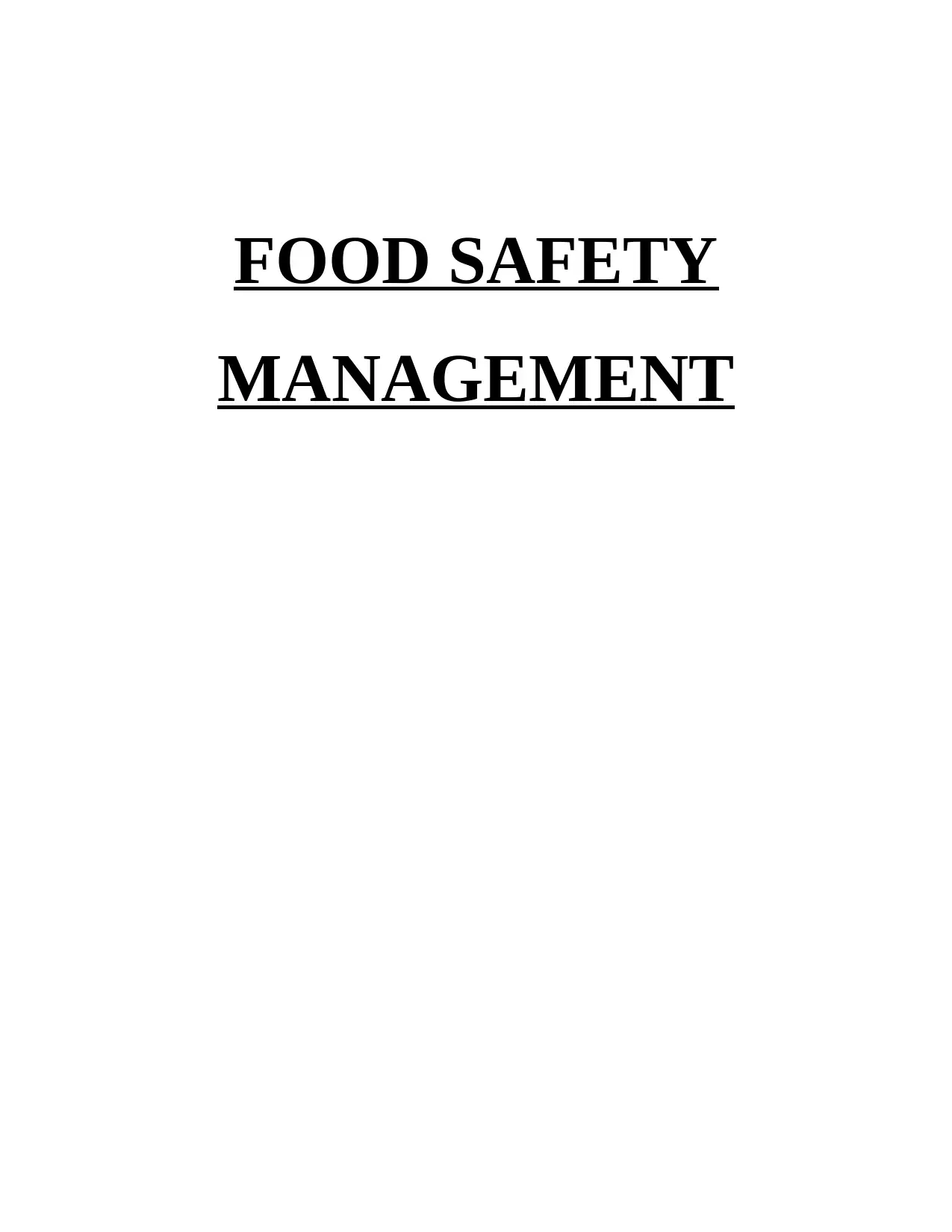
FOOD SAFETY
MANAGEMENT
MANAGEMENT
Paraphrase This Document
Need a fresh take? Get an instant paraphrase of this document with our AI Paraphraser

Table of Contents
INTRODUCTION...........................................................................................................................1
TASK A...........................................................................................................................................1
A) Methods to prevent food contamination............................................................................1
TASK B...........................................................................................................................................2
A) Agents of food spoilage ....................................................................................................2
B) Food preservation methods and their effectiveness...........................................................4
TASK C...........................................................................................................................................5
A) Methods for safe storage of food and temperature control system...................................5
B) Importance of personal hygiene........................................................................................6
D) food safety control system or HACCP plan.....................................................................8
E) Food safety guide which summarise the legal requirements............................................9
CONCLUSION..............................................................................................................................10
REFERENCES..............................................................................................................................11
INTRODUCTION...........................................................................................................................1
TASK A...........................................................................................................................................1
A) Methods to prevent food contamination............................................................................1
TASK B...........................................................................................................................................2
A) Agents of food spoilage ....................................................................................................2
B) Food preservation methods and their effectiveness...........................................................4
TASK C...........................................................................................................................................5
A) Methods for safe storage of food and temperature control system...................................5
B) Importance of personal hygiene........................................................................................6
D) food safety control system or HACCP plan.....................................................................8
E) Food safety guide which summarise the legal requirements............................................9
CONCLUSION..............................................................................................................................10
REFERENCES..............................................................................................................................11
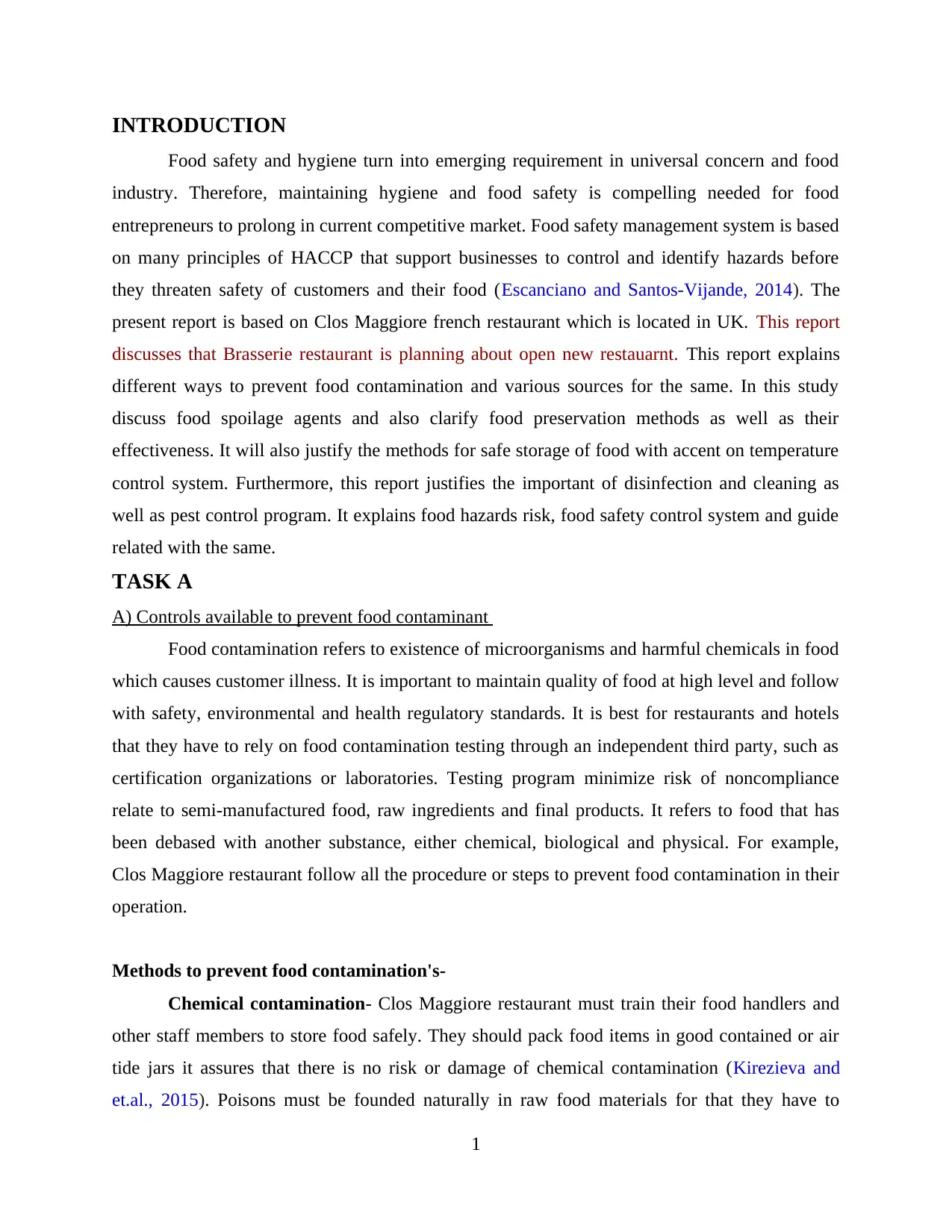
INTRODUCTION
Food safety and hygiene turn into emerging requirement in universal concern and food
industry. Therefore, maintaining hygiene and food safety is compelling needed for food
entrepreneurs to prolong in current competitive market. Food safety management system is based
on many principles of HACCP that support businesses to control and identify hazards before
they threaten safety of customers and their food (Escanciano and Santos-Vijande, 2014). The
present report is based on Clos Maggiore french restaurant which is located in UK. This report
discusses that Brasserie restaurant is planning about open new restauarnt. This report explains
different ways to prevent food contamination and various sources for the same. In this study
discuss food spoilage agents and also clarify food preservation methods as well as their
effectiveness. It will also justify the methods for safe storage of food with accent on temperature
control system. Furthermore, this report justifies the important of disinfection and cleaning as
well as pest control program. It explains food hazards risk, food safety control system and guide
related with the same.
TASK A
A) Controls available to prevent food contaminant
Food contamination refers to existence of microorganisms and harmful chemicals in food
which causes customer illness. It is important to maintain quality of food at high level and follow
with safety, environmental and health regulatory standards. It is best for restaurants and hotels
that they have to rely on food contamination testing through an independent third party, such as
certification organizations or laboratories. Testing program minimize risk of noncompliance
relate to semi-manufactured food, raw ingredients and final products. It refers to food that has
been debased with another substance, either chemical, biological and physical. For example,
Clos Maggiore restaurant follow all the procedure or steps to prevent food contamination in their
operation.
Methods to prevent food contamination's-
Chemical contamination- Clos Maggiore restaurant must train their food handlers and
other staff members to store food safely. They should pack food items in good contained or air
tide jars it assures that there is no risk or damage of chemical contamination (Kirezieva and
et.al., 2015). Poisons must be founded naturally in raw food materials for that they have to
1
Food safety and hygiene turn into emerging requirement in universal concern and food
industry. Therefore, maintaining hygiene and food safety is compelling needed for food
entrepreneurs to prolong in current competitive market. Food safety management system is based
on many principles of HACCP that support businesses to control and identify hazards before
they threaten safety of customers and their food (Escanciano and Santos-Vijande, 2014). The
present report is based on Clos Maggiore french restaurant which is located in UK. This report
discusses that Brasserie restaurant is planning about open new restauarnt. This report explains
different ways to prevent food contamination and various sources for the same. In this study
discuss food spoilage agents and also clarify food preservation methods as well as their
effectiveness. It will also justify the methods for safe storage of food with accent on temperature
control system. Furthermore, this report justifies the important of disinfection and cleaning as
well as pest control program. It explains food hazards risk, food safety control system and guide
related with the same.
TASK A
A) Controls available to prevent food contaminant
Food contamination refers to existence of microorganisms and harmful chemicals in food
which causes customer illness. It is important to maintain quality of food at high level and follow
with safety, environmental and health regulatory standards. It is best for restaurants and hotels
that they have to rely on food contamination testing through an independent third party, such as
certification organizations or laboratories. Testing program minimize risk of noncompliance
relate to semi-manufactured food, raw ingredients and final products. It refers to food that has
been debased with another substance, either chemical, biological and physical. For example,
Clos Maggiore restaurant follow all the procedure or steps to prevent food contamination in their
operation.
Methods to prevent food contamination's-
Chemical contamination- Clos Maggiore restaurant must train their food handlers and
other staff members to store food safely. They should pack food items in good contained or air
tide jars it assures that there is no risk or damage of chemical contamination (Kirezieva and
et.al., 2015). Poisons must be founded naturally in raw food materials for that they have to
1
⊘ This is a preview!⊘
Do you want full access?
Subscribe today to unlock all pages.

Trusted by 1+ million students worldwide
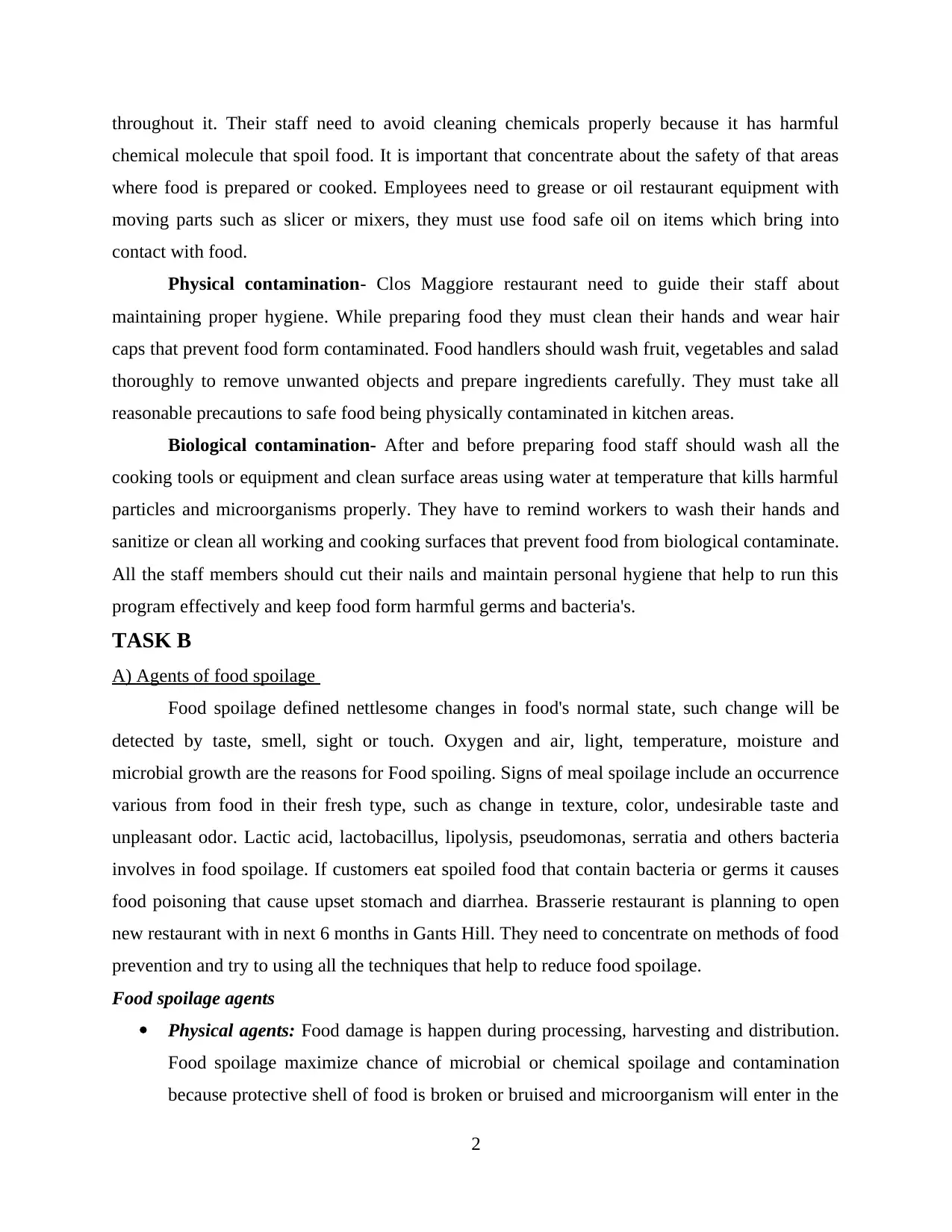
throughout it. Their staff need to avoid cleaning chemicals properly because it has harmful
chemical molecule that spoil food. It is important that concentrate about the safety of that areas
where food is prepared or cooked. Employees need to grease or oil restaurant equipment with
moving parts such as slicer or mixers, they must use food safe oil on items which bring into
contact with food.
Physical contamination- Clos Maggiore restaurant need to guide their staff about
maintaining proper hygiene. While preparing food they must clean their hands and wear hair
caps that prevent food form contaminated. Food handlers should wash fruit, vegetables and salad
thoroughly to remove unwanted objects and prepare ingredients carefully. They must take all
reasonable precautions to safe food being physically contaminated in kitchen areas.
Biological contamination- After and before preparing food staff should wash all the
cooking tools or equipment and clean surface areas using water at temperature that kills harmful
particles and microorganisms properly. They have to remind workers to wash their hands and
sanitize or clean all working and cooking surfaces that prevent food from biological contaminate.
All the staff members should cut their nails and maintain personal hygiene that help to run this
program effectively and keep food form harmful germs and bacteria's.
TASK B
A) Agents of food spoilage
Food spoilage defined nettlesome changes in food's normal state, such change will be
detected by taste, smell, sight or touch. Oxygen and air, light, temperature, moisture and
microbial growth are the reasons for Food spoiling. Signs of meal spoilage include an occurrence
various from food in their fresh type, such as change in texture, color, undesirable taste and
unpleasant odor. Lactic acid, lactobacillus, lipolysis, pseudomonas, serratia and others bacteria
involves in food spoilage. If customers eat spoiled food that contain bacteria or germs it causes
food poisoning that cause upset stomach and diarrhea. Brasserie restaurant is planning to open
new restaurant with in next 6 months in Gants Hill. They need to concentrate on methods of food
prevention and try to using all the techniques that help to reduce food spoilage.
Food spoilage agents
Physical agents: Food damage is happen during processing, harvesting and distribution.
Food spoilage maximize chance of microbial or chemical spoilage and contamination
because protective shell of food is broken or bruised and microorganism will enter in the
2
chemical molecule that spoil food. It is important that concentrate about the safety of that areas
where food is prepared or cooked. Employees need to grease or oil restaurant equipment with
moving parts such as slicer or mixers, they must use food safe oil on items which bring into
contact with food.
Physical contamination- Clos Maggiore restaurant need to guide their staff about
maintaining proper hygiene. While preparing food they must clean their hands and wear hair
caps that prevent food form contaminated. Food handlers should wash fruit, vegetables and salad
thoroughly to remove unwanted objects and prepare ingredients carefully. They must take all
reasonable precautions to safe food being physically contaminated in kitchen areas.
Biological contamination- After and before preparing food staff should wash all the
cooking tools or equipment and clean surface areas using water at temperature that kills harmful
particles and microorganisms properly. They have to remind workers to wash their hands and
sanitize or clean all working and cooking surfaces that prevent food from biological contaminate.
All the staff members should cut their nails and maintain personal hygiene that help to run this
program effectively and keep food form harmful germs and bacteria's.
TASK B
A) Agents of food spoilage
Food spoilage defined nettlesome changes in food's normal state, such change will be
detected by taste, smell, sight or touch. Oxygen and air, light, temperature, moisture and
microbial growth are the reasons for Food spoiling. Signs of meal spoilage include an occurrence
various from food in their fresh type, such as change in texture, color, undesirable taste and
unpleasant odor. Lactic acid, lactobacillus, lipolysis, pseudomonas, serratia and others bacteria
involves in food spoilage. If customers eat spoiled food that contain bacteria or germs it causes
food poisoning that cause upset stomach and diarrhea. Brasserie restaurant is planning to open
new restaurant with in next 6 months in Gants Hill. They need to concentrate on methods of food
prevention and try to using all the techniques that help to reduce food spoilage.
Food spoilage agents
Physical agents: Food damage is happen during processing, harvesting and distribution.
Food spoilage maximize chance of microbial or chemical spoilage and contamination
because protective shell of food is broken or bruised and microorganism will enter in the
2
Paraphrase This Document
Need a fresh take? Get an instant paraphrase of this document with our AI Paraphraser
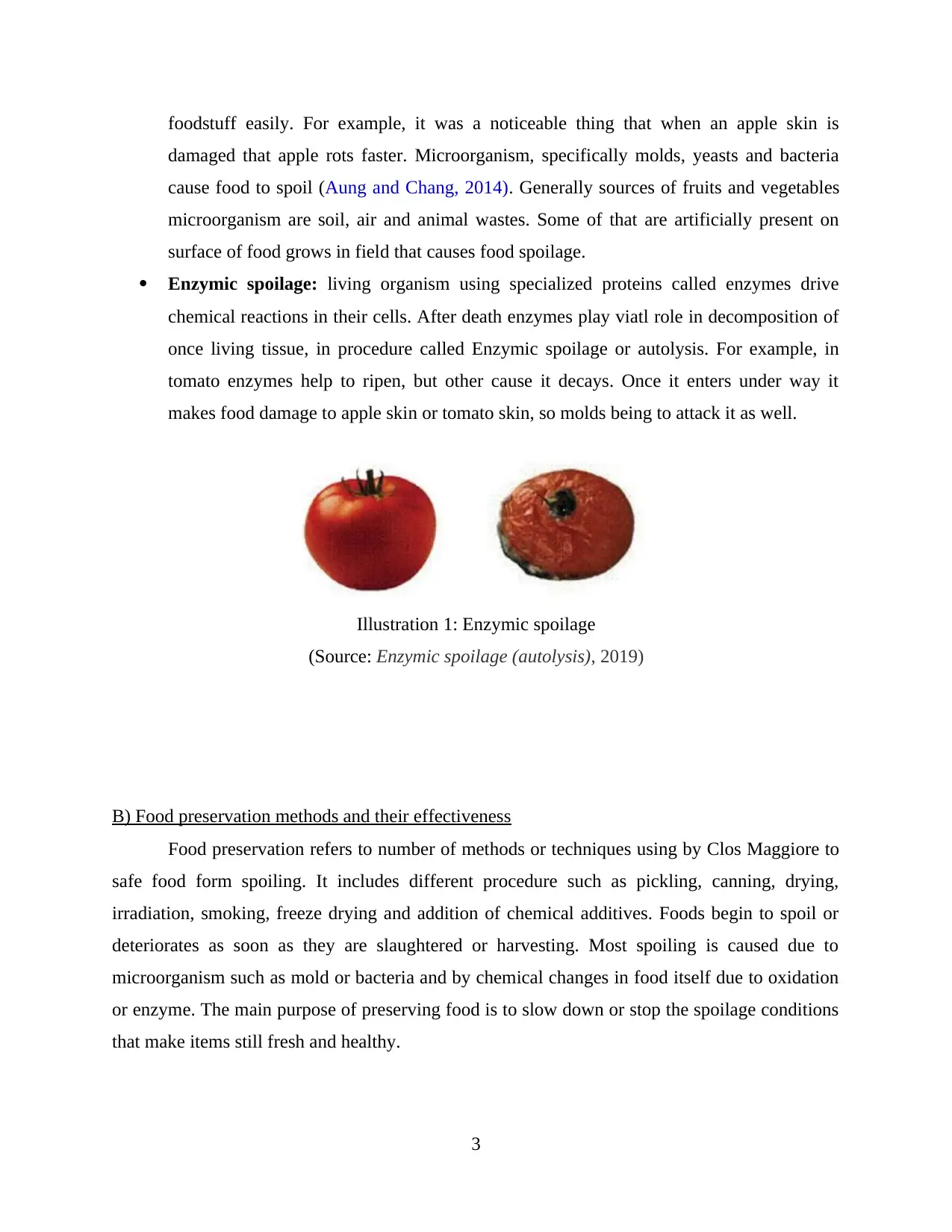
foodstuff easily. For example, it was a noticeable thing that when an apple skin is
damaged that apple rots faster. Microorganism, specifically molds, yeasts and bacteria
cause food to spoil (Aung and Chang, 2014). Generally sources of fruits and vegetables
microorganism are soil, air and animal wastes. Some of that are artificially present on
surface of food grows in field that causes food spoilage.
Enzymic spoilage: living organism using specialized proteins called enzymes drive
chemical reactions in their cells. After death enzymes play viatl role in decomposition of
once living tissue, in procedure called Enzymic spoilage or autolysis. For example, in
tomato enzymes help to ripen, but other cause it decays. Once it enters under way it
makes food damage to apple skin or tomato skin, so molds being to attack it as well.
B) Food preservation methods and their effectiveness
Food preservation refers to number of methods or techniques using by Clos Maggiore to
safe food form spoiling. It includes different procedure such as pickling, canning, drying,
irradiation, smoking, freeze drying and addition of chemical additives. Foods begin to spoil or
deteriorates as soon as they are slaughtered or harvesting. Most spoiling is caused due to
microorganism such as mold or bacteria and by chemical changes in food itself due to oxidation
or enzyme. The main purpose of preserving food is to slow down or stop the spoilage conditions
that make items still fresh and healthy.
3
Illustration 1: Enzymic spoilage
(Source: Enzymic spoilage (autolysis), 2019)
damaged that apple rots faster. Microorganism, specifically molds, yeasts and bacteria
cause food to spoil (Aung and Chang, 2014). Generally sources of fruits and vegetables
microorganism are soil, air and animal wastes. Some of that are artificially present on
surface of food grows in field that causes food spoilage.
Enzymic spoilage: living organism using specialized proteins called enzymes drive
chemical reactions in their cells. After death enzymes play viatl role in decomposition of
once living tissue, in procedure called Enzymic spoilage or autolysis. For example, in
tomato enzymes help to ripen, but other cause it decays. Once it enters under way it
makes food damage to apple skin or tomato skin, so molds being to attack it as well.
B) Food preservation methods and their effectiveness
Food preservation refers to number of methods or techniques using by Clos Maggiore to
safe food form spoiling. It includes different procedure such as pickling, canning, drying,
irradiation, smoking, freeze drying and addition of chemical additives. Foods begin to spoil or
deteriorates as soon as they are slaughtered or harvesting. Most spoiling is caused due to
microorganism such as mold or bacteria and by chemical changes in food itself due to oxidation
or enzyme. The main purpose of preserving food is to slow down or stop the spoilage conditions
that make items still fresh and healthy.
3
Illustration 1: Enzymic spoilage
(Source: Enzymic spoilage (autolysis), 2019)
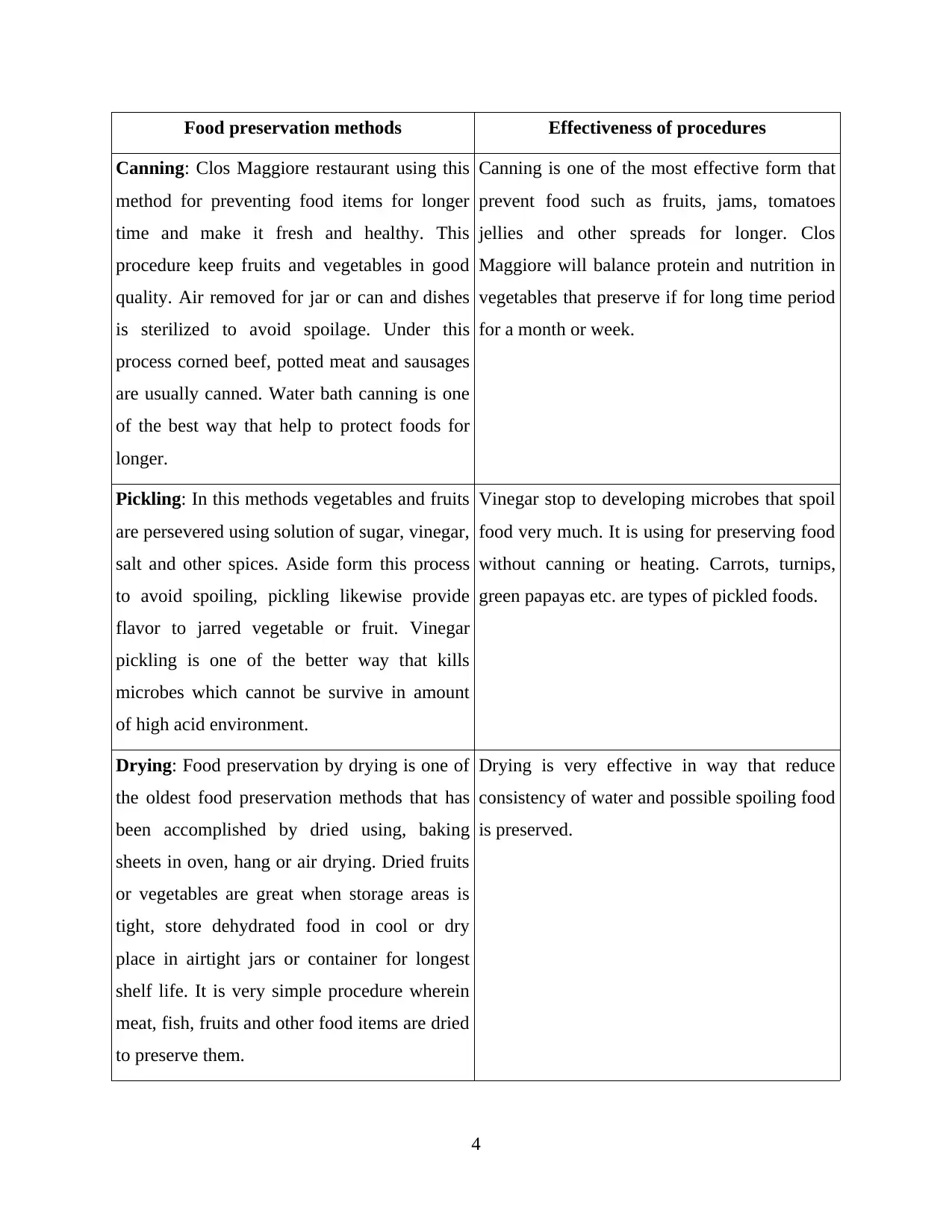
Food preservation methods Effectiveness of procedures
Canning: Clos Maggiore restaurant using this
method for preventing food items for longer
time and make it fresh and healthy. This
procedure keep fruits and vegetables in good
quality. Air removed for jar or can and dishes
is sterilized to avoid spoilage. Under this
process corned beef, potted meat and sausages
are usually canned. Water bath canning is one
of the best way that help to protect foods for
longer.
Canning is one of the most effective form that
prevent food such as fruits, jams, tomatoes
jellies and other spreads for longer. Clos
Maggiore will balance protein and nutrition in
vegetables that preserve if for long time period
for a month or week.
Pickling: In this methods vegetables and fruits
are persevered using solution of sugar, vinegar,
salt and other spices. Aside form this process
to avoid spoiling, pickling likewise provide
flavor to jarred vegetable or fruit. Vinegar
pickling is one of the better way that kills
microbes which cannot be survive in amount
of high acid environment.
Vinegar stop to developing microbes that spoil
food very much. It is using for preserving food
without canning or heating. Carrots, turnips,
green papayas etc. are types of pickled foods.
Drying: Food preservation by drying is one of
the oldest food preservation methods that has
been accomplished by dried using, baking
sheets in oven, hang or air drying. Dried fruits
or vegetables are great when storage areas is
tight, store dehydrated food in cool or dry
place in airtight jars or container for longest
shelf life. It is very simple procedure wherein
meat, fish, fruits and other food items are dried
to preserve them.
Drying is very effective in way that reduce
consistency of water and possible spoiling food
is preserved.
4
Canning: Clos Maggiore restaurant using this
method for preventing food items for longer
time and make it fresh and healthy. This
procedure keep fruits and vegetables in good
quality. Air removed for jar or can and dishes
is sterilized to avoid spoilage. Under this
process corned beef, potted meat and sausages
are usually canned. Water bath canning is one
of the best way that help to protect foods for
longer.
Canning is one of the most effective form that
prevent food such as fruits, jams, tomatoes
jellies and other spreads for longer. Clos
Maggiore will balance protein and nutrition in
vegetables that preserve if for long time period
for a month or week.
Pickling: In this methods vegetables and fruits
are persevered using solution of sugar, vinegar,
salt and other spices. Aside form this process
to avoid spoiling, pickling likewise provide
flavor to jarred vegetable or fruit. Vinegar
pickling is one of the better way that kills
microbes which cannot be survive in amount
of high acid environment.
Vinegar stop to developing microbes that spoil
food very much. It is using for preserving food
without canning or heating. Carrots, turnips,
green papayas etc. are types of pickled foods.
Drying: Food preservation by drying is one of
the oldest food preservation methods that has
been accomplished by dried using, baking
sheets in oven, hang or air drying. Dried fruits
or vegetables are great when storage areas is
tight, store dehydrated food in cool or dry
place in airtight jars or container for longest
shelf life. It is very simple procedure wherein
meat, fish, fruits and other food items are dried
to preserve them.
Drying is very effective in way that reduce
consistency of water and possible spoiling food
is preserved.
4
⊘ This is a preview!⊘
Do you want full access?
Subscribe today to unlock all pages.

Trusted by 1+ million students worldwide
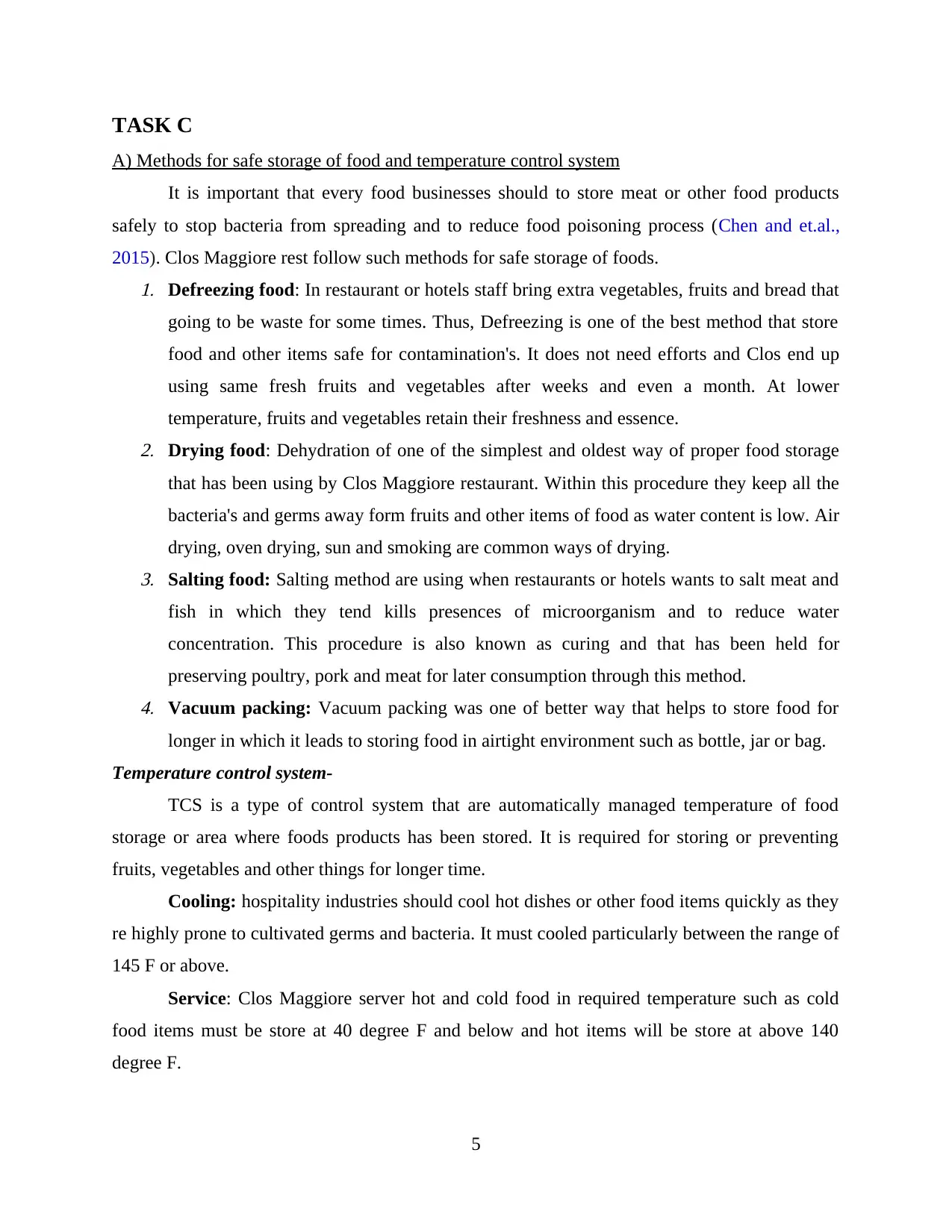
TASK C
A) Methods for safe storage of food and temperature control system
It is important that every food businesses should to store meat or other food products
safely to stop bacteria from spreading and to reduce food poisoning process (Chen and et.al.,
2015). Clos Maggiore rest follow such methods for safe storage of foods.1. Defreezing food: In restaurant or hotels staff bring extra vegetables, fruits and bread that
going to be waste for some times. Thus, Defreezing is one of the best method that store
food and other items safe for contamination's. It does not need efforts and Clos end up
using same fresh fruits and vegetables after weeks and even a month. At lower
temperature, fruits and vegetables retain their freshness and essence.2. Drying food: Dehydration of one of the simplest and oldest way of proper food storage
that has been using by Clos Maggiore restaurant. Within this procedure they keep all the
bacteria's and germs away form fruits and other items of food as water content is low. Air
drying, oven drying, sun and smoking are common ways of drying.3. Salting food: Salting method are using when restaurants or hotels wants to salt meat and
fish in which they tend kills presences of microorganism and to reduce water
concentration. This procedure is also known as curing and that has been held for
preserving poultry, pork and meat for later consumption through this method.4. Vacuum packing: Vacuum packing was one of better way that helps to store food for
longer in which it leads to storing food in airtight environment such as bottle, jar or bag.
Temperature control system-
TCS is a type of control system that are automatically managed temperature of food
storage or area where foods products has been stored. It is required for storing or preventing
fruits, vegetables and other things for longer time.
Cooling: hospitality industries should cool hot dishes or other food items quickly as they
re highly prone to cultivated germs and bacteria. It must cooled particularly between the range of
145 F or above.
Service: Clos Maggiore server hot and cold food in required temperature such as cold
food items must be store at 40 degree F and below and hot items will be store at above 140
degree F.
5
A) Methods for safe storage of food and temperature control system
It is important that every food businesses should to store meat or other food products
safely to stop bacteria from spreading and to reduce food poisoning process (Chen and et.al.,
2015). Clos Maggiore rest follow such methods for safe storage of foods.1. Defreezing food: In restaurant or hotels staff bring extra vegetables, fruits and bread that
going to be waste for some times. Thus, Defreezing is one of the best method that store
food and other items safe for contamination's. It does not need efforts and Clos end up
using same fresh fruits and vegetables after weeks and even a month. At lower
temperature, fruits and vegetables retain their freshness and essence.2. Drying food: Dehydration of one of the simplest and oldest way of proper food storage
that has been using by Clos Maggiore restaurant. Within this procedure they keep all the
bacteria's and germs away form fruits and other items of food as water content is low. Air
drying, oven drying, sun and smoking are common ways of drying.3. Salting food: Salting method are using when restaurants or hotels wants to salt meat and
fish in which they tend kills presences of microorganism and to reduce water
concentration. This procedure is also known as curing and that has been held for
preserving poultry, pork and meat for later consumption through this method.4. Vacuum packing: Vacuum packing was one of better way that helps to store food for
longer in which it leads to storing food in airtight environment such as bottle, jar or bag.
Temperature control system-
TCS is a type of control system that are automatically managed temperature of food
storage or area where foods products has been stored. It is required for storing or preventing
fruits, vegetables and other things for longer time.
Cooling: hospitality industries should cool hot dishes or other food items quickly as they
re highly prone to cultivated germs and bacteria. It must cooled particularly between the range of
145 F or above.
Service: Clos Maggiore server hot and cold food in required temperature such as cold
food items must be store at 40 degree F and below and hot items will be store at above 140
degree F.
5
Paraphrase This Document
Need a fresh take? Get an instant paraphrase of this document with our AI Paraphraser
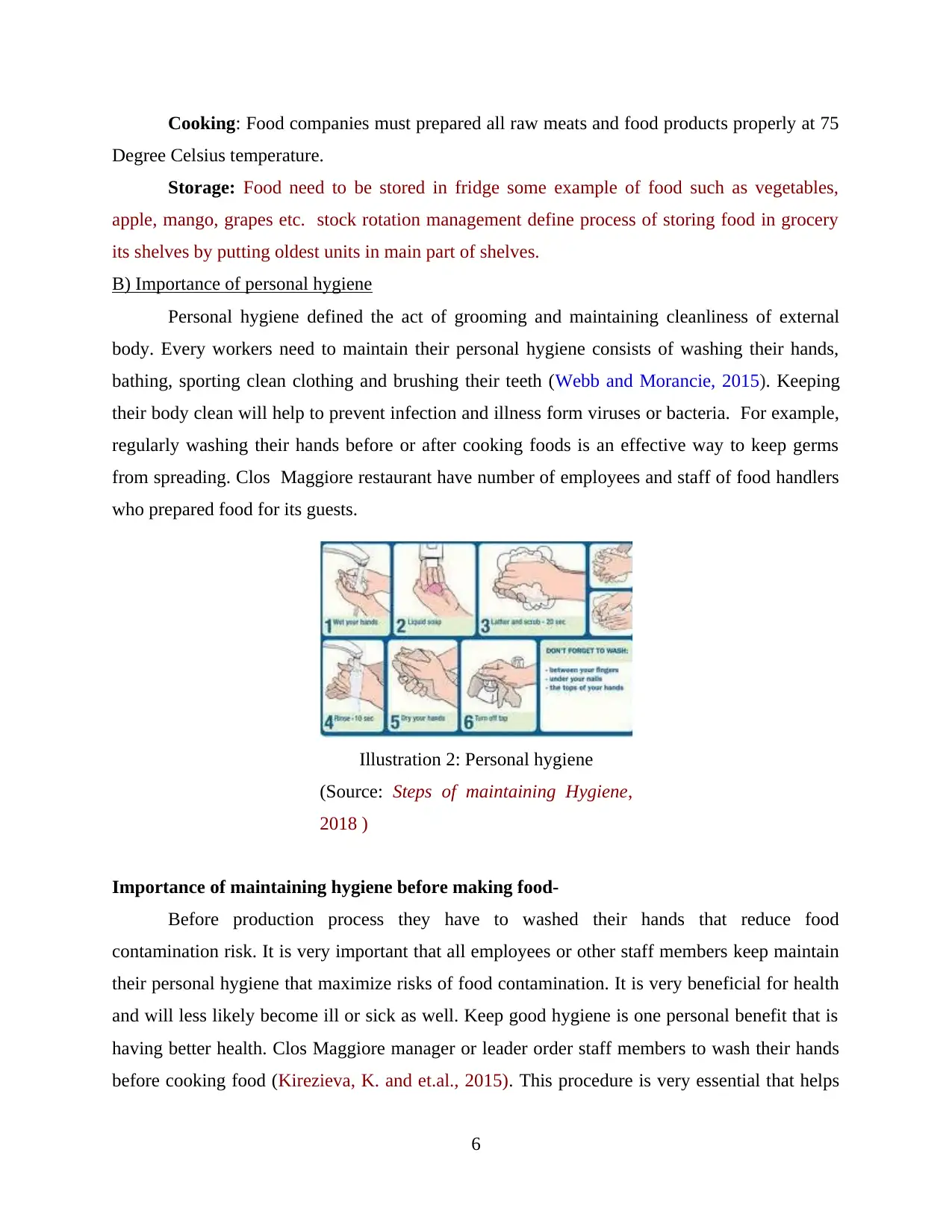
Cooking: Food companies must prepared all raw meats and food products properly at 75
Degree Celsius temperature.
Storage: Food need to be stored in fridge some example of food such as vegetables,
apple, mango, grapes etc. stock rotation management define process of storing food in grocery
its shelves by putting oldest units in main part of shelves.
B) Importance of personal hygiene
Personal hygiene defined the act of grooming and maintaining cleanliness of external
body. Every workers need to maintain their personal hygiene consists of washing their hands,
bathing, sporting clean clothing and brushing their teeth (Webb and Morancie, 2015). Keeping
their body clean will help to prevent infection and illness form viruses or bacteria. For example,
regularly washing their hands before or after cooking foods is an effective way to keep germs
from spreading. Clos Maggiore restaurant have number of employees and staff of food handlers
who prepared food for its guests.
Importance of maintaining hygiene before making food-
Before production process they have to washed their hands that reduce food
contamination risk. It is very important that all employees or other staff members keep maintain
their personal hygiene that maximize risks of food contamination. It is very beneficial for health
and will less likely become ill or sick as well. Keep good hygiene is one personal benefit that is
having better health. Clos Maggiore manager or leader order staff members to wash their hands
before cooking food (Kirezieva, K. and et.al., 2015). This procedure is very essential that helps
6
Illustration 2: Personal hygiene
(Source: Steps of maintaining Hygiene,
2018 )
Degree Celsius temperature.
Storage: Food need to be stored in fridge some example of food such as vegetables,
apple, mango, grapes etc. stock rotation management define process of storing food in grocery
its shelves by putting oldest units in main part of shelves.
B) Importance of personal hygiene
Personal hygiene defined the act of grooming and maintaining cleanliness of external
body. Every workers need to maintain their personal hygiene consists of washing their hands,
bathing, sporting clean clothing and brushing their teeth (Webb and Morancie, 2015). Keeping
their body clean will help to prevent infection and illness form viruses or bacteria. For example,
regularly washing their hands before or after cooking foods is an effective way to keep germs
from spreading. Clos Maggiore restaurant have number of employees and staff of food handlers
who prepared food for its guests.
Importance of maintaining hygiene before making food-
Before production process they have to washed their hands that reduce food
contamination risk. It is very important that all employees or other staff members keep maintain
their personal hygiene that maximize risks of food contamination. It is very beneficial for health
and will less likely become ill or sick as well. Keep good hygiene is one personal benefit that is
having better health. Clos Maggiore manager or leader order staff members to wash their hands
before cooking food (Kirezieva, K. and et.al., 2015). This procedure is very essential that helps
6
Illustration 2: Personal hygiene
(Source: Steps of maintaining Hygiene,
2018 )
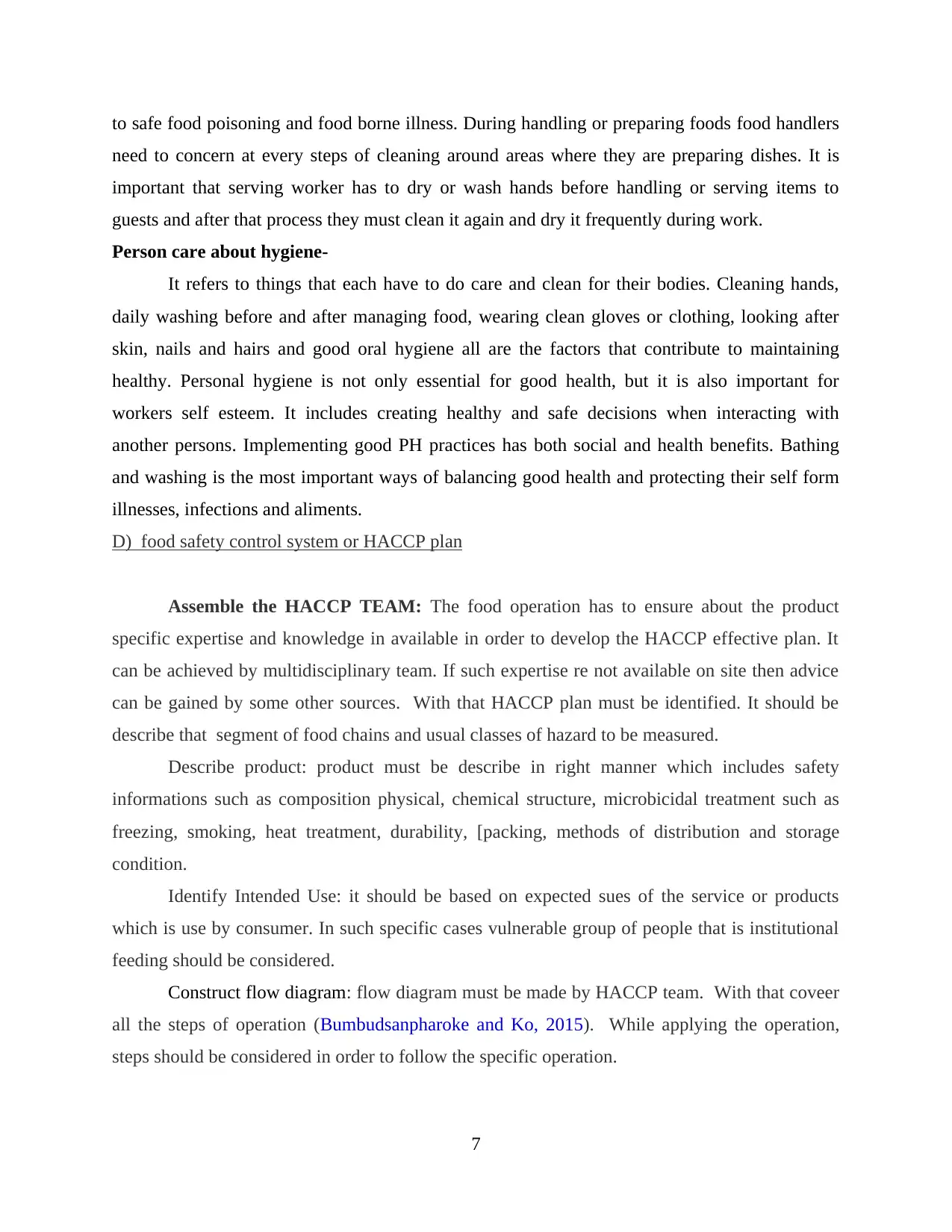
to safe food poisoning and food borne illness. During handling or preparing foods food handlers
need to concern at every steps of cleaning around areas where they are preparing dishes. It is
important that serving worker has to dry or wash hands before handling or serving items to
guests and after that process they must clean it again and dry it frequently during work.
Person care about hygiene-
It refers to things that each have to do care and clean for their bodies. Cleaning hands,
daily washing before and after managing food, wearing clean gloves or clothing, looking after
skin, nails and hairs and good oral hygiene all are the factors that contribute to maintaining
healthy. Personal hygiene is not only essential for good health, but it is also important for
workers self esteem. It includes creating healthy and safe decisions when interacting with
another persons. Implementing good PH practices has both social and health benefits. Bathing
and washing is the most important ways of balancing good health and protecting their self form
illnesses, infections and aliments.
D) food safety control system or HACCP plan
Assemble the HACCP TEAM: The food operation has to ensure about the product
specific expertise and knowledge in available in order to develop the HACCP effective plan. It
can be achieved by multidisciplinary team. If such expertise re not available on site then advice
can be gained by some other sources. With that HACCP plan must be identified. It should be
describe that segment of food chains and usual classes of hazard to be measured.
Describe product: product must be describe in right manner which includes safety
informations such as composition physical, chemical structure, microbicidal treatment such as
freezing, smoking, heat treatment, durability, [packing, methods of distribution and storage
condition.
Identify Intended Use: it should be based on expected sues of the service or products
which is use by consumer. In such specific cases vulnerable group of people that is institutional
feeding should be considered.
Construct flow diagram: flow diagram must be made by HACCP team. With that coveer
all the steps of operation (Bumbudsanpharoke and Ko, 2015). While applying the operation,
steps should be considered in order to follow the specific operation.
7
need to concern at every steps of cleaning around areas where they are preparing dishes. It is
important that serving worker has to dry or wash hands before handling or serving items to
guests and after that process they must clean it again and dry it frequently during work.
Person care about hygiene-
It refers to things that each have to do care and clean for their bodies. Cleaning hands,
daily washing before and after managing food, wearing clean gloves or clothing, looking after
skin, nails and hairs and good oral hygiene all are the factors that contribute to maintaining
healthy. Personal hygiene is not only essential for good health, but it is also important for
workers self esteem. It includes creating healthy and safe decisions when interacting with
another persons. Implementing good PH practices has both social and health benefits. Bathing
and washing is the most important ways of balancing good health and protecting their self form
illnesses, infections and aliments.
D) food safety control system or HACCP plan
Assemble the HACCP TEAM: The food operation has to ensure about the product
specific expertise and knowledge in available in order to develop the HACCP effective plan. It
can be achieved by multidisciplinary team. If such expertise re not available on site then advice
can be gained by some other sources. With that HACCP plan must be identified. It should be
describe that segment of food chains and usual classes of hazard to be measured.
Describe product: product must be describe in right manner which includes safety
informations such as composition physical, chemical structure, microbicidal treatment such as
freezing, smoking, heat treatment, durability, [packing, methods of distribution and storage
condition.
Identify Intended Use: it should be based on expected sues of the service or products
which is use by consumer. In such specific cases vulnerable group of people that is institutional
feeding should be considered.
Construct flow diagram: flow diagram must be made by HACCP team. With that coveer
all the steps of operation (Bumbudsanpharoke and Ko, 2015). While applying the operation,
steps should be considered in order to follow the specific operation.
7
⊘ This is a preview!⊘
Do you want full access?
Subscribe today to unlock all pages.

Trusted by 1+ million students worldwide
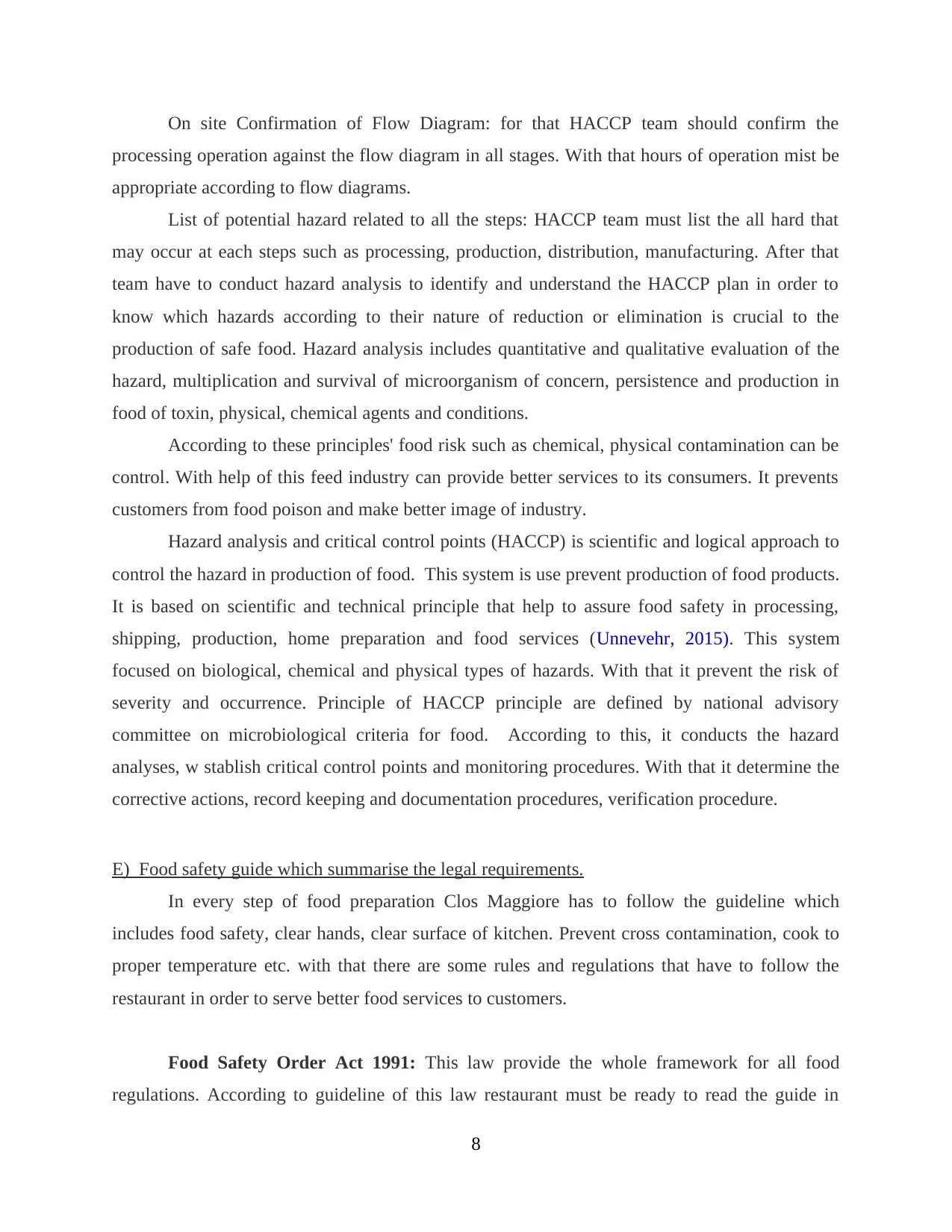
On site Confirmation of Flow Diagram: for that HACCP team should confirm the
processing operation against the flow diagram in all stages. With that hours of operation mist be
appropriate according to flow diagrams.
List of potential hazard related to all the steps: HACCP team must list the all hard that
may occur at each steps such as processing, production, distribution, manufacturing. After that
team have to conduct hazard analysis to identify and understand the HACCP plan in order to
know which hazards according to their nature of reduction or elimination is crucial to the
production of safe food. Hazard analysis includes quantitative and qualitative evaluation of the
hazard, multiplication and survival of microorganism of concern, persistence and production in
food of toxin, physical, chemical agents and conditions.
According to these principles' food risk such as chemical, physical contamination can be
control. With help of this feed industry can provide better services to its consumers. It prevents
customers from food poison and make better image of industry.
Hazard analysis and critical control points (HACCP) is scientific and logical approach to
control the hazard in production of food. This system is use prevent production of food products.
It is based on scientific and technical principle that help to assure food safety in processing,
shipping, production, home preparation and food services (Unnevehr, 2015). This system
focused on biological, chemical and physical types of hazards. With that it prevent the risk of
severity and occurrence. Principle of HACCP principle are defined by national advisory
committee on microbiological criteria for food. According to this, it conducts the hazard
analyses, w stablish critical control points and monitoring procedures. With that it determine the
corrective actions, record keeping and documentation procedures, verification procedure.
E) Food safety guide which summarise the legal requirements.
In every step of food preparation Clos Maggiore has to follow the guideline which
includes food safety, clear hands, clear surface of kitchen. Prevent cross contamination, cook to
proper temperature etc. with that there are some rules and regulations that have to follow the
restaurant in order to serve better food services to customers.
Food Safety Order Act 1991: This law provide the whole framework for all food
regulations. According to guideline of this law restaurant must be ready to read the guide in
8
processing operation against the flow diagram in all stages. With that hours of operation mist be
appropriate according to flow diagrams.
List of potential hazard related to all the steps: HACCP team must list the all hard that
may occur at each steps such as processing, production, distribution, manufacturing. After that
team have to conduct hazard analysis to identify and understand the HACCP plan in order to
know which hazards according to their nature of reduction or elimination is crucial to the
production of safe food. Hazard analysis includes quantitative and qualitative evaluation of the
hazard, multiplication and survival of microorganism of concern, persistence and production in
food of toxin, physical, chemical agents and conditions.
According to these principles' food risk such as chemical, physical contamination can be
control. With help of this feed industry can provide better services to its consumers. It prevents
customers from food poison and make better image of industry.
Hazard analysis and critical control points (HACCP) is scientific and logical approach to
control the hazard in production of food. This system is use prevent production of food products.
It is based on scientific and technical principle that help to assure food safety in processing,
shipping, production, home preparation and food services (Unnevehr, 2015). This system
focused on biological, chemical and physical types of hazards. With that it prevent the risk of
severity and occurrence. Principle of HACCP principle are defined by national advisory
committee on microbiological criteria for food. According to this, it conducts the hazard
analyses, w stablish critical control points and monitoring procedures. With that it determine the
corrective actions, record keeping and documentation procedures, verification procedure.
E) Food safety guide which summarise the legal requirements.
In every step of food preparation Clos Maggiore has to follow the guideline which
includes food safety, clear hands, clear surface of kitchen. Prevent cross contamination, cook to
proper temperature etc. with that there are some rules and regulations that have to follow the
restaurant in order to serve better food services to customers.
Food Safety Order Act 1991: This law provide the whole framework for all food
regulations. According to guideline of this law restaurant must be ready to read the guide in
8
Paraphrase This Document
Need a fresh take? Get an instant paraphrase of this document with our AI Paraphraser

detail. With that staff must know the main role's and responsibility related to outline of guideline.
With that includes food imports and exports, labelling, safety, product withdrawal and recalls,
traceability etc.
Food Hygiene Regulation 2006: According to this law restaurant has to ensure about the
activities are carried out in proper hygiene practices. This guideline includes manufacturing,
preparation, packing, processing, distribution, storage, selling and supplying, transportation. That
must be traceable. According to this food premise should be maintained and lean in good repair,
have proper hand washing facilities, suitable pest control in place and with that must provide
adequate drainage.
CONCLUSION
In this report has been concluded that food safety is very important part of effective
management. It discusses methods to prevent food contamination that safe foods for contaminant
and spoilage. This presentation discussed about various sources of food contamination and
discuss agents of food spoilage. In this unit discussed about food preservation methods that store
food products or items for longer time. Moreover, their effectiveness and methods for safe
storage of food that prevent fruits, vegetables and other things in good quality. This study
evaluate importance of disinfection and cleaning as well as pest control system that help to safe
food dishes for long period. Furthermore, it discusses hygienic design and food safety control
system that safe items effectively and also guide legal requirement of company that run business
smoothly. Companies has to follow all the rules and regulations covered in Food Hygiene
Regulation 2006 and Food Safety Order Act 1991 that helps to run business effectively. It is very
important to maintained personal hygiene that help to prevent people to make ill.
9
With that includes food imports and exports, labelling, safety, product withdrawal and recalls,
traceability etc.
Food Hygiene Regulation 2006: According to this law restaurant has to ensure about the
activities are carried out in proper hygiene practices. This guideline includes manufacturing,
preparation, packing, processing, distribution, storage, selling and supplying, transportation. That
must be traceable. According to this food premise should be maintained and lean in good repair,
have proper hand washing facilities, suitable pest control in place and with that must provide
adequate drainage.
CONCLUSION
In this report has been concluded that food safety is very important part of effective
management. It discusses methods to prevent food contamination that safe foods for contaminant
and spoilage. This presentation discussed about various sources of food contamination and
discuss agents of food spoilage. In this unit discussed about food preservation methods that store
food products or items for longer time. Moreover, their effectiveness and methods for safe
storage of food that prevent fruits, vegetables and other things in good quality. This study
evaluate importance of disinfection and cleaning as well as pest control system that help to safe
food dishes for long period. Furthermore, it discusses hygienic design and food safety control
system that safe items effectively and also guide legal requirement of company that run business
smoothly. Companies has to follow all the rules and regulations covered in Food Hygiene
Regulation 2006 and Food Safety Order Act 1991 that helps to run business effectively. It is very
important to maintained personal hygiene that help to prevent people to make ill.
9

REFERENCES
Books and Journals
Aung, M.M. and Chang, Y.S., 2014. Traceability in a food supply chain: Safety and quality
perspectives. Food control. 39. pp.172-184.
Bumbudsanpharoke, N. and Ko, S., 2015. Nano‐food packaging: an overview of market,
migration research, and safety regulations. Journal of food science. 80(5). pp.R910-
R923.
Chen, C., Zhang, J. and Delaurentis, T., 2014. Quality control in food supply chain management:
An analytical model and case study of the adulterated milk incident in
China. International Journal of Production Economics. 152. pp.188-199.
Chen, E and et.al., 2015. Implementation of non-regulatory food safety management schemes in
New Zealand: a survey of the food and beverage industry. Food control. 47. pp.569-
576.
Escanciano, C. and Santos-Vijande, M.L., 2014. Reasons and constraints to implementing an
ISO 22000 food safety management system: Evidence from Spain. Food Control. 40.
pp.50-57.
Gil, M.I. and et.al., 2015. Pre-and postharvest preventive measures and intervention strategies to
control microbial food safety hazards of fresh leafy vegetables. Critical reviews in food
science and nutrition. 55(4). pp.453-468.
Grimm, J.H., Hofstetter, J.S. and Sarkis, J., 2014. Critical factors for sub-supplier management:
A sustainable food supply chains perspective. International Journal of Production
Economics. 152. pp.159-173.
Jacxsens, L. and et.al., 2015. Measuring microbial food safety output and comparing self-
checking systems of food business operators in Belgium. Food Control. 49. pp.59-69.
Kirezieva, K. and et.al., 2015. Factors affecting the status of food safety management systems in
the global fresh produce chain. Food Control. 52. pp.85-97.
Kussaga, J.B. and et.al., 2014. Challenges in performance of food safety management systems: a
case of fish processing companies in Tanzania. Journal of food protection. 77(4).
pp.621-630.
Liu, A. and Niyongira, R., 2017. Chinese consumers food purchasing behaviors and awareness of
food safety. Food Control. 79. pp.185-191.
10
Books and Journals
Aung, M.M. and Chang, Y.S., 2014. Traceability in a food supply chain: Safety and quality
perspectives. Food control. 39. pp.172-184.
Bumbudsanpharoke, N. and Ko, S., 2015. Nano‐food packaging: an overview of market,
migration research, and safety regulations. Journal of food science. 80(5). pp.R910-
R923.
Chen, C., Zhang, J. and Delaurentis, T., 2014. Quality control in food supply chain management:
An analytical model and case study of the adulterated milk incident in
China. International Journal of Production Economics. 152. pp.188-199.
Chen, E and et.al., 2015. Implementation of non-regulatory food safety management schemes in
New Zealand: a survey of the food and beverage industry. Food control. 47. pp.569-
576.
Escanciano, C. and Santos-Vijande, M.L., 2014. Reasons and constraints to implementing an
ISO 22000 food safety management system: Evidence from Spain. Food Control. 40.
pp.50-57.
Gil, M.I. and et.al., 2015. Pre-and postharvest preventive measures and intervention strategies to
control microbial food safety hazards of fresh leafy vegetables. Critical reviews in food
science and nutrition. 55(4). pp.453-468.
Grimm, J.H., Hofstetter, J.S. and Sarkis, J., 2014. Critical factors for sub-supplier management:
A sustainable food supply chains perspective. International Journal of Production
Economics. 152. pp.159-173.
Jacxsens, L. and et.al., 2015. Measuring microbial food safety output and comparing self-
checking systems of food business operators in Belgium. Food Control. 49. pp.59-69.
Kirezieva, K. and et.al., 2015. Factors affecting the status of food safety management systems in
the global fresh produce chain. Food Control. 52. pp.85-97.
Kussaga, J.B. and et.al., 2014. Challenges in performance of food safety management systems: a
case of fish processing companies in Tanzania. Journal of food protection. 77(4).
pp.621-630.
Liu, A. and Niyongira, R., 2017. Chinese consumers food purchasing behaviors and awareness of
food safety. Food Control. 79. pp.185-191.
10
⊘ This is a preview!⊘
Do you want full access?
Subscribe today to unlock all pages.

Trusted by 1+ million students worldwide
1 out of 14
Related Documents
Your All-in-One AI-Powered Toolkit for Academic Success.
+13062052269
info@desklib.com
Available 24*7 on WhatsApp / Email
![[object Object]](/_next/static/media/star-bottom.7253800d.svg)
Unlock your academic potential
Copyright © 2020–2026 A2Z Services. All Rights Reserved. Developed and managed by ZUCOL.





